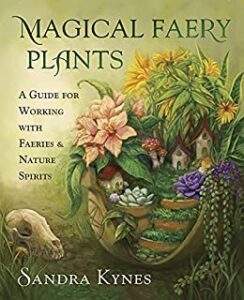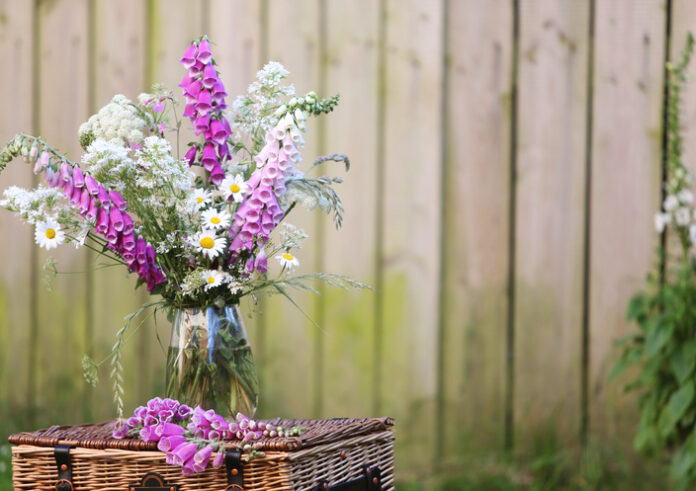Throughout folklore, many plants were associated with faeries and a number of them were noted as being especially favored by the fae. Growing even one special plant in your garden can attract faeries and aid you in working with them. Of course, the plants have magical uses and faeries can help guide you.
- Foxglove (Digitalis purpurea): Also known as elf gloves, fairy bells, fairy caps, fairy petticoats, and fox bells. Perhaps more than most, this plant is closely associated with faeries, and in many legends they are said to be especially delighted with the flowers. With their long, bell-like shape, the flowers were said to create a magical sound. For magical use: Because it is said to be a favored plant, hold a leaf between your hands without removing it from the plant as you whisper a greeting to the faeries and welcome them to your garden.
- Lady’s Smock (Cardamine pratensis): Also known as meadow cress and milkmaids. This plant was believed to be sacred to faeries and according to legend it would only grow in places that were special to them. Looking like little smocks on a clothesline, the flowers were said to be dresses sewn by elves. For magical use: Place a sachet of dried flowers on your altar during divination sessions for guidance.
- Lavender: English Lavender (Lavandula angustifolia): Also known as elf leaf. Wearing a circlet of lavender flowers on Midsummer‘s Eve and tossing a few sprigs into the bonfire was said to enable a person to see elves and faeries. For magical use: The scent of lavender enhances awareness and intuition for dream work and all forms of psychic work. The scent also aids in contacting spirit guides.
- Lilac: French Lilac (Syringa vulgaris): The scent of lilac is so ethereal that it seems to have come from the faery realm. A white lilac flower with five petals instead of four is called a luck lilac and is said to be a gift from the fae. For magical use: Place a twig on your desk or somewhere in your workspace to foster inspiration and increase creativity. Dry a cluster or two of flowers to use as a charm to attract love.
- Lily of the Valley (Convallaria majalis): Also known as fairy cups, fairy ladder, May bells, and May lily. According to legend, faeries were gathering dew and hung their cups on blades of grass when they stopped to dance. Having taken too long, their cups became stuck to the grass and Lily of the Valley was created. For magical use: Dry a few of roots, grind them into a powder, and use it in charms to overcome challenges and reach goals.
- Maidenhair Fern (Adiantum capillus-veneris): Also known as fairy fern. According to legend, faeries wore crowns of maidenhair fern for important festive occasions. They also rolled up the fronds to use as pillows. For magical use: To enhance defensive magic, carry a small pouch with dried or powdered leaves. Maidenhair fern is also instrumental for banishing anything unwanted from your life.
- Rose: Dog Rose (Rosa canina): Also known as beach rose and wild briar. Enamored with roses in general, faeries are said to find cavorting in dog rose thickets especially fun. The rose hip from a dog rose bush is known as a pixy pear. For magical use: To help ground and center your energy before a divination session, hold a rose leaf or flower petal between your hands. Also do this before bed to encourage prophetic dreams.
- Rosemary (Rosmarinus officinalis): Also known as elf leaf. In the Netherlands, rosemary was believed to mark a place where elves gathered. Favored by the fae in Sicily, the flowers were said to serve as cradles for baby faeries. For magical use: Hang a sachet of dried flowers on the headboard of your bed for help in remembering dreams. Rosemary is also effective in binding and banishing spells.
- St. John’s Wort (Hypericum perforatum): Also known as Penny-John and rosin rose. At their feast on Midsummer’s Eve, faeries were said to dance around St. John’s wort plants and splash them with cowslip wine. St. John’s wort is reputedly a daytime disguise for faery horses. For magical use: Burn a few dried leaves in a fireplace or cauldron and let its pungent smoke purify your house and/or ritual area.
- Tulip: Common Garden Tulip (Tulipa gesneriana): Also known as Didier’s tulip. Faeries were said to lull their babies to sleep in tulips before going dancing in the meadows. Any tulip that seemed to live longer than other flowers in a garden was reputedly a faery baby cradle. For magical use: Carry a tulip bulb as an amulet for luck, or place a vase of flowers in your kitchen to invite abundance into your home.
- Wood Anemone: European (Anemone nemorosa), North American (A. quinquefolia): Also known as fairy windflower and wood windflower. Wood anemones are reputed to be a great favorite of the faeries. According to legend, the fae painted the stakes on the flowers in the moonlight. For magical use: To bolster courage, carry three seeds in your purse or pocket. For luck, blow on the first wood anemone you see in the spring and make a wish.
- Yellow Iris (Iris pseudacorus): Also known as flag lily, sword lily, and yellow flag. In Celtic legends, faeries were often described as having hair the color of yellow iris. In England, faeries were said to nestle in the flowers during the day. For magical use: Keep a picture of yellow iris on your desk or in your workspace to act as a muse for creative inspiration. Burn a dried flower in a spell to bring success.
Including a plant or two in your garden that faeries are fond of shows your interest and sincerity and will help in building a relationship. A garden does not have to be large; it can consist of several flowerpots on a porch or balcony. The important thing is to make it welcoming and special, and they will come.
Here’s a look at Sandra’s Magical Faery Plants
Build Relationships with Faeries and Connect with Nature on a Deep, Soul Level
The natural world is integral to our spiritual and magical lives and the lives of faeries and nature spirits. With this book, you’ll discover how plants bridge the worlds and help us work with these extraordinary beings. Drawing from folklore, history, and personal experience, Sandra Kynes teaches you all about faery magic and the unique ways that plants enhance your connection to the fae.
This comprehensive guide presents over one hundred profiles of common and obscure plants associated with faeries and nature spirits. Grow bracken fern to attract faeries to your property. Hold a small bundle of vervain to help you communicate with nature spirits. Set out a bowl of blackberries as a token of friendship. With hands-on activities and exercises, this book shows you how to journey to faeryland, conduct dreamwork, and heal both yourself and the planet.
ABOUT THE AUTHOR:
 Sandra Kynes (Mid-coast Maine) is a member of the Order of Bards, Ovates & Druids and the author of seventeen books, including Star Magic, Llewellyn’s Complete Book of Correspondences, Mixing Essential Oils for Magic, and Sea Magic. Additionally, her work has been featured in Utne Reader, The Portal, and Circle Magazine. Sandra’s writing also appears regularly in Llewellyn’s popular almanacs and datebooks.
Sandra Kynes (Mid-coast Maine) is a member of the Order of Bards, Ovates & Druids and the author of seventeen books, including Star Magic, Llewellyn’s Complete Book of Correspondences, Mixing Essential Oils for Magic, and Sea Magic. Additionally, her work has been featured in Utne Reader, The Portal, and Circle Magazine. Sandra’s writing also appears regularly in Llewellyn’s popular almanacs and datebooks.
COPYRIGHT (2022) Llewellyn Worldwide, Ltd. All rights reserved.






